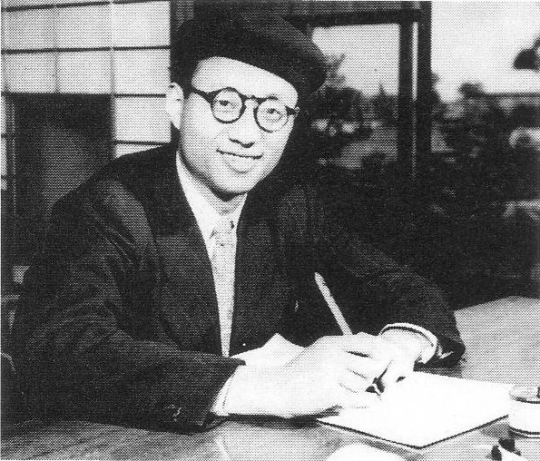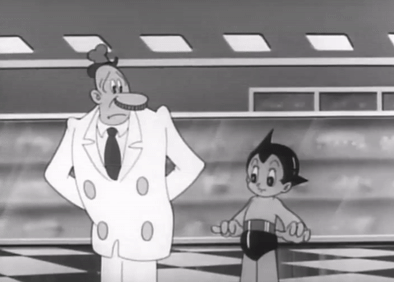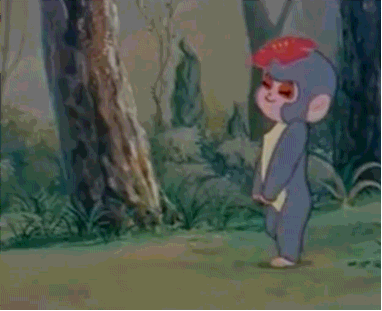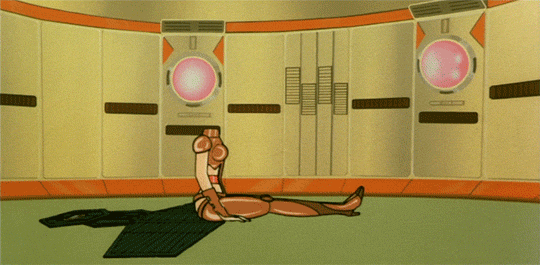originally posted at https://canmom.tumblr.com/post/668230...
Damn, Animation Night 80. That is a whole lot of Animation Nights all right.
In about twelve hours I’ll be boarding a plane to America to land in the arms of my beloved @mogsk - but before I go, I need to stay up to align my sleep cycle and make damn sure I don’t miss the plane, so let’s spend this long night watching a few animated films~
Tonight we’ll be rolling the clock way way back, to the one of the foundational mangakas and the absolute dawn of ‘anime’ as a tradition with its own distinctive look and terrible working conditions. That’s right - it’s time we told the story of the ‘Godfather of Manga’ [マンガの教父], Osamu Tezuka [手塚 治虫]!

…who is oddly camera-shy, with this picture from 1951 being one of the very few I can find.
Tezuka’s story is, of course, very long - and if you want to read about it there is (what else) a manga telling it, though I don’t seem to be able to find a good source for scans. Alternatively, you can turn to the excellent writing of Matteo Watzky, who’s kind of eclipsed even kVin as my go-to guy for sakuga writing lol.
Long before he got established in anime - in the days when Toei was basically the only game in town - Tezuka became established as one of the most popular creators of the new format of manga. He started drawing comics very young, even before the second world war, later citing influences like the Takarazuka revue, Disney films, and the Chinese animated film Princess Iron Fan (see: Animation Night 27), and continued through the war while working in a factory; afterwards, he received medical training but also started to find an audience for his comics.
There’s a great deal of argument among professional weebs historians of manga about whether the form is mostly based on older Japanese traditions like picture scrolls and kamishibai street theatre, or if its origins come from the broader tradition of comics internationally; I don’t really have any idea who has the right of that one and it’s perhaps ultimately unanswerable. By Tezuka’s time, certain formats, like the yonkoma [4-panel comedy strip], were already established; Tezuka’s first serialised work Diary of Mā-chan (1946) was a yonkoma.
At the encouragement of his friend Sakai Shichima, Tezuka started on a more narrative work called Shin Takarajima [New Treasure Island], loosely adapted from Treasure Island - and this became an enormous success, credited with beginning the manga boom. You can read a great deal about the background to this manga here on The Comics Journal.

But this would all soon be eclipsed by Tezuka’s most famous work, Tetsuwan Atom [Mighty Atom] (1952), better known in English as Astro Boy. (The character first appeared in a much less successful short story called Ambassador Atom (1951-2), but only the Atom character really caught anyone’s imaginations). There’s a cute little anecdote that comes up here:
One day, while working at a hospital, Tezuka was punched in the face by a frustrated American G.I. This encounter gave Tezuka the idea to include the theme of Atom’s interaction with aliens.[19]
Astro Boy featured a childlike robot and soon became a flagship manga alongside
Not long after, he made a first unsuccessful effort at beginning what would become his “life’s work”, the manga series Phoenix, which is the subject of tonight’s Animation Night. More on that shortly.
Of course, Tezuka isn’t known merely as a famous mangaka - he is the person who invented the TV anime. So how did that come about?
Tezuka’s first role in animation was actually at Toei, where he was hired - already a famous mangaka - to create storyboards for their films, starting with Saiyūki, an adaptation of the Journey to the West. The result was mixed, as Watzky recounts in this article on the origins Tokyo Movie Shinsha:
In 1959, the famous mangaka signed a contract with Toei that stipulated that he would storyboard three Toei movies. In fact, he only storyboarded the first, Saiyûki, and only wrote the other two (Sinbad the Sailor and Wanwan Chûshingura). Tezuka was very slow and took an entire year to complete his storyboard, but took the opportunity to visit Toei often with two assistants, Shôtarô Ishinomori and Sadao Tsukioka [Clements, 2013, p.113]. According to Yasuo Otsuka’s memoirs, Tezuka’s storyboard was met in a contradictory manner. On one hand, the pacing was too irregular and the plot too complex – which meant that it had to be significantly re-written. But on the other hand, Otsuka recalls that “Tezuka’s drawings were modern to start with”, which made animating much easier [quoted in Clements, 2013, p.113].
Tezuka was very dissatisfied with the modifications to his original storyboard, which is why he only wrote the two other movies. But the production of Saiyûki was capital : Tezuka could see how an animated movie was produced and made a lot of contacts, but also discovered the already very difficult working conditions of animators. Indeed, the director of Saiyûki, Taiji Yabushita, was hospitalized at the end of production, and was probably the first victim of what Yasuji Mori called the “anime syndrome” [Quoted in Clements, 2013, p.103].

Before long, he left Toei, founding his own anime studio Mushi Productions in 1961 with only seven employees. But it was a good time to make a rival anime studio: as we discussed back on night 70, intense labour struggles at Toei were causing many animators to leave the company, and Tezuka was able to scoop them up. Among them were many future ‘big names’, such as Rintaro (Animation Night 53).
Back then we followed the strand which remained at Toei, particularly Miyazaki and Takahata - so now let’s head over to MushiPro. We can find the next bit of the story at Wikipedia:
In 1961, Tezuka entered the animation industry in Japan by founding the production company Mushi Productions as a rival of Toei Animation. His initial staff was composed of animators he had met while working on Saiyuki that he convinced to join by paying the animators more than double what Toei was paying them as well as paying for food. Their first film was Tales from a Certain Street Corner (Aru Machikado no Monogatari). An ‘anti-Disney’, experimental film. Just like on Saiyuki, Tezuka would often fall behind his own deadlines, and the staff would have to pick up the slack only for Tezuka to take credit for it later.
On Saiyuki, the animators had started experimenting with the techniques of limited animation - which refers to the suite of methods that animators use to save work compared to Disneyesque ‘full’ animation: low framerates, re-using drawings (e.g. in walk cycles), partial animation (only redrawing part of a drawing), ‘bank’ footage that could be reused in different contexts (e.g. transformation sequences). This became the signature of MushiPro, especially when Tezuka decided to try out the seemingly insane project of creating anime to air on television - an adaptation of his own manga Astro Boy.
Tezuka believed that he could only compete with animation by undercutting his competitors - which meant that, although he initially tempted animators away from Toei with doubled pay and free food, the rates he could pay his animators were ludicrously low, and the pace of work was intense. This, unfortunately, set a precedent which continues to this day with little improvement. MushiPro created a number of classic TV anime based on Tezuka’s manga in the 60s, such as Kimba the White Lion [ジャングル大帝 Jungle Emperor] (1965-66).

But the model was totally unsustainable, and it did not ultimately work out for MushiPro either. Despite the popularity of some of their TV anime, in particular in American localisation, the company gradually slid into insolvency. As a last ditch effort, Tezuka tried making adult films with the animerama trilogy, of which the best known is legendary arthouse film Belladonna of Sadness which we watched on Animation Night 69. It could not save MushiPro, which collapsed, only to rise again in the form of studios like Madhouse and Sunrise.
Tezuka on the other hand left the wreckage just fine, founding a new company called Tezuka Productions, there creating a variety of very experimental animation. But he also returned to manga, pivoting hard from his previous hyper-childlike character designs to a more realistic style inspired by the rise of adult-oriented gekiga manga. And in this context, he returned to Pheonix [火の鳥 hi no tori (Bird of Fire)] in 1967, serialised in his own magazine COM.
The manga is split into a series of chapters, each set in a different historical period, linked by the character of an immortal phoenix. The first two chapters are set in feudal Japan and a distant apocalyptic future; the later chapters gradually converged towards the present day, but the manga remained unfinished at the time of Tezuka’s death in 1989.

Many of those chapters ended up adapted into movies. These movies were largely not directed by Tezuka himself, but by a variety of his colleagues. We have:
- Hi no Tori (1978), a long live-action jidaigeki film directed by Kon Ichikawa, based on the first chapter
- Phoenix 2772 [Hi no Tori 2772] (1980), an animated film dir. Taku Sugiyama, based on the Future chapter but also mixing in various other bits of Phoenix. More on that shortly!
- Phoenix: Karma Chapter [Hi no Tori: Hō-ō Hen] (1986), a 60-minute animated film dir. Rintaro
- Phoenix: Yamato/Space Chapter (1987), a two-part OVA dir. Toshio Hirata (Yamato) and Yoshiaki Kawajiri (Space)
- Hi no Tori (2004), a 13-episode TV series dir. Ryōsuke Takahashi (best known for Armored Trooper VOTOMS)
Of these the most notable is probably 2772, which caught my attention when I saw a tweet with an astonishingly elaborate bit of hand-animated 3D camerawork. The story behind it turns out to be pretty fascinating: key animator Junji Kobayashi created an elaborate 3D structure in a hallway to use as animation reference. Tezuka’s extreme ambitions for this film led him to hire a lot more staff at Tezuka Productions and “implement a 24-hour schedule”, which I sure hope doesn’t mean the animators were pulling 24-hour shifts but you never know in this industry.
So, tonight what I have for you is… the four Phoenix animated films from the 80s, that is, 2772, Karma Chapter, Yamato Chapter and Space Chapter.
But in addition to that… I also have a collection of Tezuka’s experimental short animated films largely from the 60s and 80s, for which I can thank @mogsk and her BakaBT access <3 I’m sure not all these films will hit, but there’s definitely some gems in there, like Jumping (1984) which includes some equally ludicrous perspective work to portray a child’s imagination leaping between different countries. So I’m looking forward to digging in there.
I know this is a much later start than usual, but I hope you’ll join me in https://twitch.tv/canmom for the one very horny man who got the ball rolling on this whole ‘anime’ thing! Animation Night 80 will be starting almost immediately~
Comments